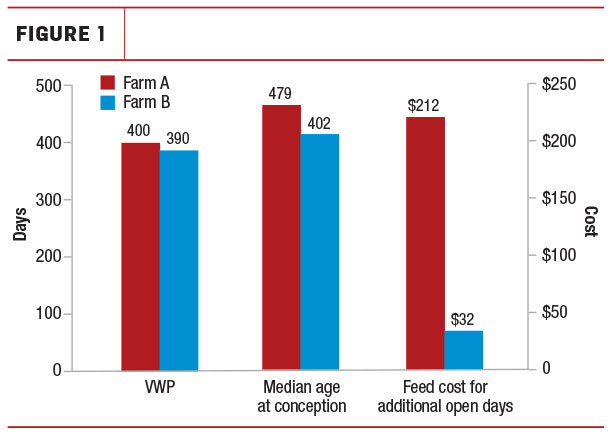Improved heifer raising and reproduction results in fewer total days on feed, earlier return on investment, improved cash flow by having fewer heifers on feed and more milking cows, increased first-lactation milk and more lifetime milk.
A webinar hosted by Dairy Girl Network featuring Matthew Boyle, DVM, dairy technical service veterinarian with Zoetis, discussed impacts an aggressive heifer reproduction program can have on profitability within the herd.
Heifer reproductive management is essentially the same as for the adult cow. However, financial opportunity and value can be gained by consistently bringing heifers into the milking herd at a common target of 22 to 24 months.
However, Boyle cautioned producers to consider the distribution around the 24-month benchmark that brings us to the average. What percentage of heifers calve beyond the benchmark? If it is greater than 50 percent, there is plenty of room for tightening the distribution and a significant economic opportunity for the farm.
“We can’t achieve a profitable age at first calving if we don’t first focus on the reproduction piece, which is driven by age at first service,” Boyle said. “Then, age at first service must become consistent throughout the heifer herd.”
Heifers should reproductively outperform the cow herd, but Boyle’s study of 47 herds on pregnancy rate revealed heifers achieved only a 19 percent pregnancy rate. “Heifers conceive at a pretty efficient rate,” Boyle said. “It’s really driven by insemination intensity.”
It is not uncommon for heifers to be given up to nine cycles of opportunity to conceive and then are eventually turned out for natural conception with a herd bull. Boyle suggests culling after three or four unsuccessful services and no more than six cycles of breeding opportunity. Heifers turned out with a bull after artificial insemination often result in keeping females that would have otherwise been culled. Ending efforts after the sixth cycle results in a heifer cull rate of approximately 5 percent or less in most herds.
“Insemination efficiency is key to improving heifer pregnancy rates,” Boyle added. “The improvement comes in improved heat detection and frequency of open diagnosis through veterinary examinations.”
Two examples show the financial implications of an aggressive heifer insemination program using a feed cost of $2.67 per day.
The first farm (Farm A) targets a 400-day voluntary waiting period (VWP) with a median age at conception of 479 days. The additional 79 days to conception adds $212 per head in feed costs while heifers remain open.
The second farm (Farm B) targets a 390-day VWP and aggressively pursues heat detection and insemination. The median age at conception is lowered to 402 days, with only 12 days open from the target VWP. Feed costs for her additional open days are lowered to $32.

A good fixed-time insemination program is one way to fix and improve heat detection. Prostaglandin costs approximately $2.50 per dose. If one use saves one day of large heifer feeding costs, it is marginally profitable, but any additional saved days are pure profit.
Observational data from one large herd among Boyle’s clients shows more profit opportunities for calving at 22 to 24 months compared to 25 months or older (see Table 1). The younger group saw only 4.2 percent culling during the first 60 days in milk, while 7.9 percent of the 25-month and older calving group left the herd in the same time frame. The 305-day milk yield was 25,269 pounds for the early calvers and 25,091 pounds for the older group.

Overall, cows are removed from the herd at approximately the same age. Entering the herd at 22 months versus 25 months makes an impact on productive life and the dollars the cow contributes to the bottom line. In addition to the extra expense of feeding heifers beyond the target calving age, every month beyond the 22-month calving age costs more than $100 per head in lost milk production opportunity.
Emphasis on heifer reproduction helps the farm capitalize on all the investments of calf care. Proper colostrum feeding yields improved health and average daily gain. Early nutrition and growth results in suppression of chronic disease, especially respiratory problems. Healthy, growthy heifers are ready to breed at an appropriate age and size, yielding cows that contribute a full lifetime value of their genetic potential to the herd and the farm’s overall well-being.
Boyle offered five steps to better heifer reproduction management:
- Move heifers to the breeding pen every week (or biweekly depending on herd size).
- Ensure heifers are bred shortly after entering the A.I. pen. Administer prostaglandin on the day of movement into the breeding pen and again 10 to 12 days later for heifers not yet inseminated.
- Make sure all heifers are inseminated, and synchronize those heifers not inseminated during the first 28 days in the A.I. pen.
- Perform routine pregnancy checks and reconfirms. Identify pregnant females and move them out; re-enroll open heifers in the breeding program. Reconfirm pregnancies at 70 to 90 days, and cull heifers that abort.
- Run monitor reports after every pregnancy check including the following: VWP compliance, distribution of first breeding, pregnancy rate per insemination rate, and conception rate.

Bev Berens is a freelance writer in Holland, Michigan.
PHOTO: Staff photo.





